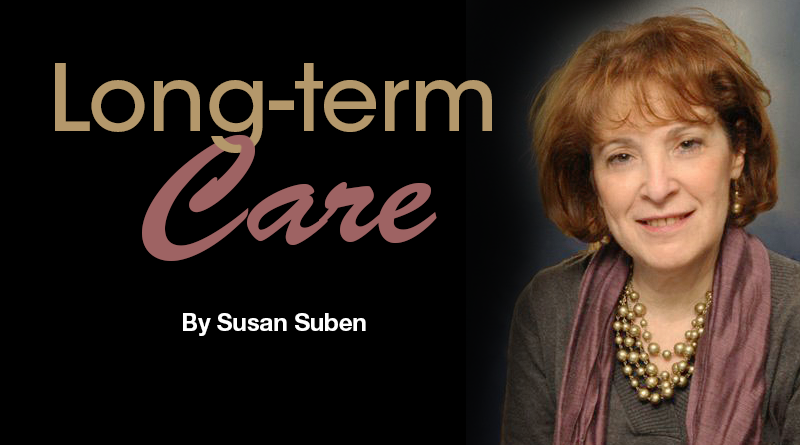The Truthful Facts Pose a Challenge
Cost of long-term care is rising. Will you be able to afford it?
By Susan Suben
 I think many of us 55 and over youngsters remember the show “Dragnet.” The show’s trademark opening narration was — “Ladies and gentlemen: the story you are about to hear is true.” Joe Friday, the show’s quintessential police detective, had a famous line as well — “Just the facts, ma’am. Just the facts.”
I think many of us 55 and over youngsters remember the show “Dragnet.” The show’s trademark opening narration was — “Ladies and gentlemen: the story you are about to hear is true.” Joe Friday, the show’s quintessential police detective, had a famous line as well — “Just the facts, ma’am. Just the facts.”
Well, I’m here to tell you the truth about long-term care and challenge you to plan for it.
For as long as I have been writing this column, I have tried to impress upon you that the rising costs of long-term care make it a very real risk in retirement. We know that every year, everything increases in cost — groceries, movie tickets, a cup of coffee. But I don’t think I have ever really given you hard facts about the cost of home care, assisted living and nursing home care based upon empirical evidence.
Each year, Genworth, a long-term care insurance carrier that has been in the LTC insurance business for over 30 years, conducts its cost of care survey. The company recently released its 2017 findings. I would like to share these findings with you in an effort to stress your need to plan for the future.
First, the methodology. Care Scout, a Genworth company, contacted more than 47,000 providers to complete more 15,000 surveys of home care, adult day care, assisted living facilities and nursing homes. Every state is represented and the survey feedback determined the median cost of care in each geographical location.
In addition to the current costs, the survey shows how the cost of care changed since 2016 and the five-year annual growth.
Under the umbrella of home care, Genworth looked at homemaker services and home health aides provided through non-Medicare certified, licensed agencies. Homemaker services include cooking, cleaning, laundry, running errands and general upkeep of the home. Home health aides offer personal care with activities of daily living such as bathing and dressing.
The national median hourly rate is $21 for homemaker services. This is a 4.75 percent increase over 2016 and the five year annual growth is 3.08 percent. The national median hourly rate for a home health aide is $22 which is 6.17 percent higher since 2016 and the annual five year growth is 2.5 percent.
For adult day care, the national median daily rate is $70 which is a 2.94 percent increase since 2016 and a 2.79 percent increase over five years.
The national median rate for assisted living averages $3,750 per month, which is a 3.36 percent increase over 2016 and a 2.59 percent increase over five years.
The national median rates for a semi-private and private room are substantially lower than the costs in the Rochester area, which I will outline below. They average $235 and $267 with a 4.44 percent and 5.50 percent increase since 2016 and a five year annual growth of 3.28 percent and 3.76 percent.
How does this compare with the cost of care in Rochester? The average hourly rate for homemaker services is $25 and $26/hour for home health aides. The daily rate for adult day care is approximately $90. The monthly rate for assisted living is $3,975 ($132 per day). The monthly rate for a semi-private nursing home room is $10,737 ($294 per day) and $12,799 ($426 perday) for a private room.
Now that your mind is swimming with all of these facts, why should this be important to you?
All of this information is invaluable for several reasons. Most importantly, if you know your assets and what the cost of LTC is and expected to be, can you afford to ignore this risk and pay out-of-pocket? The survey makes second guessing unnecessary.
When considering long-term care coverage through a stand-alone LTC insurance policy or a life insurance policy with LTC component, one of the features you have to be cognizant of is inflation protection.
Today, the gold standard for inflation protection is 3 percent compound which is well below the 5 percent compound that was the most chosen inflation factor up to about five years ago. Is 3 percent compound inflation protection adequate? According to the figures above, it is as long as you are prepared to do some cost sharing which most people are in order to keep insurance premiums manageable.
If you plan on moving to another state, long-term care could cost substantially more or less than your current location and this can have a dramatic effect on the purchase of a LTC planning product in terms of affordability and cost-sharing. The Genworth study provides a map of all 50 states with the median cost of care.
So take this information to heart and be proactive. Long-term care is expensive and certainly requires planning. Accept the challenge to be prepared for your future.
Susan Suben is a senior certified adviser and president of Long Term Care Associates, Inc. and Elder Care Planning. She is a consultant for Canandaigua National Bank & Trust Company. She can be reached at 800-422-2655 or by email at susansuben@31greenbush.com.

